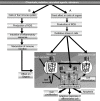Human adult stem cells as the target cells for the initiation of carcinogenesis and for the generation of "cancer stem cells"
- PMID: 24855504
- PMCID: PMC4021771
- DOI: 10.15283/ijsc.2008.1.1.8
Human adult stem cells as the target cells for the initiation of carcinogenesis and for the generation of "cancer stem cells"
Abstract
The inference to stem cells has been found in ancient myths and the concept of stem cells has existed in the fields of plant biology, developmental biology and embryology for decades. In the field of cancer research, the stem cell theory was one of the earliest hypotheses on the origin of a cancer from a single cell. However, an opposing hypothesis had it that an adult differentiated somatic cell could "de-differentiate" to become a cancer cell. Only within the last decade, via the "cloning" of Dolly, the sheep, did the field of stem cell biology really trigger an exciting revolution in biological research. The isolation of human embryonic stem cells has created a true revolution in the life sciences that has led to the hope that these human stem cells could lead to (a) basic science understanding of gene regulation during differentiation and development; (b) stem cell therapy; (c) gene therapy via stem cells; (d) the use of stem cells for drug discovery; (e) screening for toxic effects of chemicals; and (f) understand the aging and diseases of aging processes.
Keywords: Adult stem cells; De-differentiation theory; Initiation/promotion/progression hypothesis of carcinogenesis; Oct-4; Re-programming; Stem cell theory of carcinogenesis; iPS cells.
Figures



Similar articles
-
Review paper: cancer stem cells and cancer nonstem cells: from adult stem cells or from reprogramming of differentiated somatic cells.Vet Pathol. 2009 Mar;46(2):176-93. doi: 10.1354/vp.46-2-176. Vet Pathol. 2009. PMID: 19261629 Review.
-
From adult stem cells to cancer stem cells: Oct-4 Gene, cell-cell communication, and hormones during tumor promotion.Ann N Y Acad Sci. 2006 Nov;1089:36-58. doi: 10.1196/annals.1386.018. Ann N Y Acad Sci. 2006. PMID: 17261754 Review.
-
Induction of iPS cells and of cancer stem cells: the stem cell or reprogramming hypothesis of cancer?Anat Rec (Hoboken). 2014 Jan;297(1):161-73. doi: 10.1002/ar.22793. Epub 2013 Dec 2. Anat Rec (Hoboken). 2014. PMID: 24293264 Review.
-
Evolution of energy metabolism, stem cells and cancer stem cells: how the warburg and barker hypotheses might be linked.Int J Stem Cells. 2012 May;5(1):39-56. doi: 10.15283/ijsc.2012.5.1.39. Int J Stem Cells. 2012. PMID: 24298354 Free PMC article.
-
The Concept of "Cancer Stem Cells" in the Context of Classic Carcinogenesis Hypotheses and Experimental Findings.Life (Basel). 2021 Nov 27;11(12):1308. doi: 10.3390/life11121308. Life (Basel). 2021. PMID: 34947839 Free PMC article.
Cited by
-
What Can Chemical Carcinogenesis Shed Light on the LNT Hypothesis in Radiation Carcinogenesis?Dose Response. 2019 Sep 18;17(3):1559325819876799. doi: 10.1177/1559325819876799. eCollection 2019 Jul-Sep. Dose Response. 2019. PMID: 31565039 Free PMC article.
-
Localisation Microscopy of Breast Epithelial ErbB-2 Receptors and Gap Junctions: Trafficking after γ-Irradiation, Neuregulin-1β, and Trastuzumab Application.Int J Mol Sci. 2017 Feb 9;18(2):362. doi: 10.3390/ijms18020362. Int J Mol Sci. 2017. PMID: 28208769 Free PMC article.
-
Evidence for immortality and autonomy in animal cancer models is often not provided, which causes confusion on key issues of cancer biology.J Cancer. 2020 Mar 4;11(10):2887-2920. doi: 10.7150/jca.41324. eCollection 2020. J Cancer. 2020. PMID: 32226506 Free PMC article. Review.
-
Targeting Cancer Stem Cells-A Renewed Therapeutic Paradigm.Oncol Hematol Rev. 2017;13(1):45-55. doi: 10.17925/ohr.2017.13.01.45. Epub 2017 May 23. Oncol Hematol Rev. 2017. PMID: 33959299 Free PMC article.
-
The gap junction as a "Biological Rosetta Stone": implications of evolution, stem cells to homeostatic regulation of health and disease in the Barker hypothesis.J Cell Commun Signal. 2011 Mar;5(1):53-66. doi: 10.1007/s12079-010-0108-9. Epub 2010 Dec 9. J Cell Commun Signal. 2011. PMID: 21484590 Free PMC article.
References
-
- Jones L. Stem cells: so what’s in a niche? Curr Biol. 2001;11:R484–R486. - PubMed
-
- Strachan T, Read AP, editors. Human Molecular Genetics. New York: Routledge; 2004. 3rd Chapt 3.
-
- Markert C. Genetic control of cell interactions in chimeras. Develop Genet. 1984;4:267–279.
-
- Coleman WB, McCullough KD, Esch GL, Faris RA, Hixson DC, Smith GJ, Grisham JW. Evaluation of the differentiation potential of WB-F344 rat liver epithelial stem-like cells in vivo. Differentiation to hepatocytes after transplantation into dipeptidylpeptidase-IV-deficient rat liver. Am J Pathol. 1997;151:353–359. - PMC - PubMed
-
- Hayflick L. The limited in vitro lifetime of human diploid cell strains. Exp Cell Res. 1965;37:614–636. - PubMed
Publication types
LinkOut - more resources
Full Text Sources

